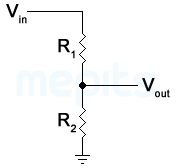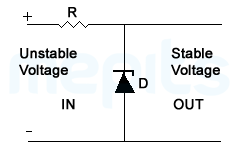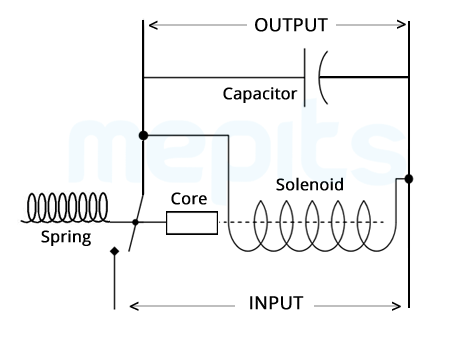Sections
The purpose of voltage regulators is to provide a constant output voltage even if the input voltage is varied. Different types of voltage regulators are available in the market. The Basic principle of a voltage regulator is to compare the output voltage with a fixed value and minimize the difference. Different types of voltage regulators are.
It is the simplest form of a voltage regulator. If the voltage requirement is less than the available voltage, then a voltage divider circuit is enough to modulate the available voltage to the required value. This kind of voltage regulator arrangement is only feasible in the case of small circuits, where, the power consumption is very less, whereas, in circuits having larger currents, a lot of power gets dissipated at the bias resistors. Here the input voltage needs to be constant to get a steady output. The variations in the load also affect the output voltage.

Here, output voltage V-out is less than input voltage. The extra voltage is dissipated as heat across the resistor R1. Output is taken across R2. The output voltage can be derived as

Voltage divider circuit is less preferred in electronic circuits. One main drawback of voltage divider circuit is that the output voltage will not remain constant when the input is varied. And the second drawback is that the excess voltage is dissipated as heat which will affect the efficiency of the circuit. Zener regulator uses the property of reverse biased Zener diode. As shown in the figure, load is connected across the Zener diode.

https://www.mepits.com/tutorial/22/Diodes/Working-of-Zener-Diode-
In a simple transistor regulator, Zener diode is connected at the base of an NPN transistor in common collector configuration. Zener diode at the base of the transistor provides the reference voltage for the regulator. Efficiency of transistor voltage regulator is even, when load current is large. Since, collector and emitter terminal of the transistor is connected in series with the load it is called a series voltage regulator and transistor is called as a series pass transistor.

When input voltage is increased momentarily the output voltage will also increase. Since base voltage of the transistor is kept constant using Zener diode, increase in output voltage decreases the base-emitter voltage. Decrease in base-emitter voltage, decreases the level of conduction, in turn reducing the output voltage.
When load resistance is decreased, output voltage will tend to increase. This increases the base-emitter voltage thereby decreasing the collector to emitter current. The increase in collector current will compensate the voltage drop caused by the decrease in load resistance.
Thus output voltage remains constant during both load and supply variations. In this type of regulator, the energy that corresponds to excess voltage is dissipated at the transistor in the form of heat

As shown in the figure, the electromechanical voltage regulator has a solenoid connected across the output terminal. If the output voltage is constant, then, the flux induced in the coil will be very small. When the output voltage is increased, the current increases and so does the strength of the magnetic field. The flux induced in the solenoid attracts the magnetic core physically with a moving arm of a switch. When the switch is open, it isolates the load from the input supply. As the voltage is decreased, the current also decreases which in turn reduces the strength of the magnetic field. Recoil spring brings back the switch to the closed position. This switching is very fast and so the output voltage remains constant even if the input voltage is fluctuating.
Due to high frequency switching, noise in the circuit will be very large. Noise can be reduced and accuracy in the output voltage can be increased by replacing the switch with a range of resistors or a transformer winding. Output voltage can be increased or decreased by selecting a proper resistor value or a corresponding transformer winding.

Switched mode power supply or SMPS is now the most preferred electronic power supply system. In conventional voltage regulators, the difference between input voltage and required voltage is dissipated as heat and due to this the efficiency of the system is very poor. In SMPS, the required power is transferred to the load and so only a negligible power is wasted.
From the power supply, a low frequency AC is given to rectifier circuit followed by a filter. The direct current so obtained is fed to a high frequency switching circuit followed by a step down transformer. A final rectifier will convert this high frequency signal into DC output. The amplitude of the output voltage depends on the duty cycle of the control signal, given at the base of the transistor switch. A PWM Oscillator is used for this control signal generation. Duty cycle of this PWM signal depends on the amplitude of its input, which is the difference between output voltage and the reference voltage. If the output is less than the required value then, a positive voltage is given to PWM oscillator which increases its duty cycle. Now the transistor ON time is increased such that, more power is transferred to the output thereby increasing the output voltage.
High frequency transistor switching in the circuit has two main advantages. When transistor is used as a switch, in ON-OFF states either voltage across the transistor is negligible or the current through the transistor is negligible. So power loss always remains very low. This improves the efficiency of the system. Second advantage is that the high frequency switching replaces bulky and heavy low frequency transformers by small and light high frequency transformers.
Sections